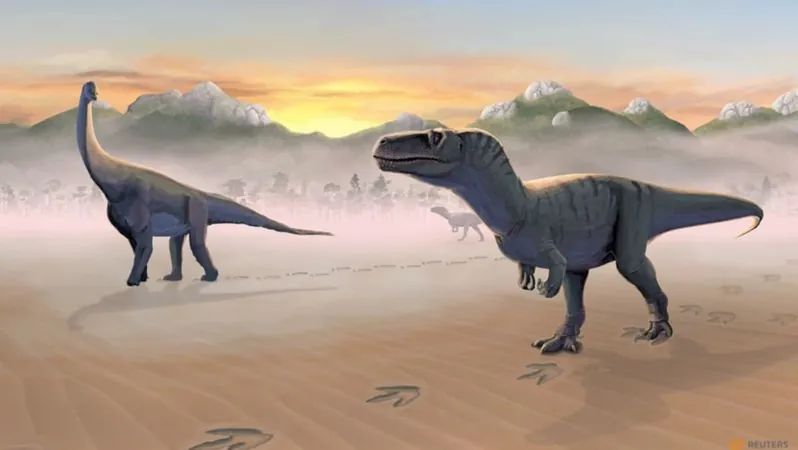
A Glimpse into Prehistoric Life: Isle of Skye's Dinosaur Footprints Reveal Ancient Ecosystem
2025-04-02
Author: Ming
A Glimpse into Prehistoric Life
The Isle of Skye, known for its breathtaking views and rich history, is more than just a picturesque destination. This rugged Scottish coastline also serves as a window into a distant past, revealing the footprints of dinosaurs that roamed the Earth approximately 167 million years ago during the Jurassic Period. Recent research highlights the discovery of 131 fossilized tracks from both meat-eating and plant-eating dinosaurs, all found along the shores of what is now referred to as Prince Charles Point.
A Tranquil Snapshot of Dinosaurs
In a breathtaking setting that once resembled a subtropical lagoon, these ancient creatures likely congregated in harmony, perhaps akin to modern-day animals visiting watering holes in the savannah. Lead researcher Tone Blakesley from the University of Edinburgh explains, “It’s very much a tranquil snapshot of dinosaurs gathering, perhaps to drink or move between vegetated areas. The herbivores present at the time faced no immediate threats from predators.” This unprecedented find provides insight into the behavioral patterns of these prehistoric giants, offering a glimpse into their daily lives, which bone fossils alone cannot deliver.
Meat-Eaters and Plant-Eaters
Though the precise species responsible for these tracks remain uncertain, paleontologists have drawn logical conclusions based on their shape and size. The meat-eating dinosaurs belong to the theropods, particularly a family known as megalosaurs. One prominent candidate is the Megalosaurus, a formidable predator that existed around 100 million years before the renowned Tyrannosaurus rex, measuring approximately 20 feet in length and armed with sharp teeth.
On the other end of the spectrum, the plant-eaters are identified as part of the sauropod group, famous for their long necks and massive bodies. A potential representative of this group is the Cetiosaurus, which could reach lengths of up to 52 feet.
Fascinating Footprints
Measurements reveal fascinating details about the footprints: theropod tracks are about 18 inches long, featuring imprints of three toes, while the sauropod imprints are round, measuring around 20 inches, characterized by four stubby triangular toes. This diverse array of footprints—evidence of at least two dozen individual dinosaurs—was meticulously documented through digital modeling aided by drone technology.
The Jurassic Ecosystem of Skye
The Jurassic ecosystem of Skye was teeming with life, nestled within a vast river estuary surrounded by lush forests, flourishing with conifers, tree ferns, and even ginkgoes, many of which have relatives still thriving today. In addition to dinosaurs, this environment shared its space with a myriad of other creatures, including crocodiles, turtles, small mammals, and pterosaurs, the flying reptiles of that age.
Insights from Paleontologists
“The footprints from this era are extraordinarily rare, but when they are discovered, they offer a direct glimpse into how these dinosaurs lived and interacted with their surroundings,” said Steve Brusatte, a prominent paleontologist from the University of Edinburgh and senior author of the study. He draws intriguing parallels between Scotland’s storied past and its deep prehistoric roots.
A Connection to Human History
While the renowned Bonnie Prince Charlie sought refuge in this very land after his defeat in 1746, his escape echoes through time, as he unknowingly traversed the same ground once occupied by these magnificent ancient creatures. “When the prince was running for his life, he was treading on the footsteps of Jurassic dinosaurs,” Brusatte notes, capturing the extraordinary intersection of human history and the prehistoric world.
Conclusion: Shaping Our Understanding of Evolution
The stunning revelations from the Isle of Skye illuminate not just the past of dinosaurs, but also how the remnants of their existence continue to shape our understanding of Earth's evolutionary history. Discover more about this captivating find, as scientists unlock the mysteries of a world long gone but not forgotten.

 Brasil (PT)
Brasil (PT)
 Canada (EN)
Canada (EN)
 Chile (ES)
Chile (ES)
 Česko (CS)
Česko (CS)
 대한민국 (KO)
대한민국 (KO)
 España (ES)
España (ES)
 France (FR)
France (FR)
 Hong Kong (EN)
Hong Kong (EN)
 Italia (IT)
Italia (IT)
 日本 (JA)
日本 (JA)
 Magyarország (HU)
Magyarország (HU)
 Norge (NO)
Norge (NO)
 Polska (PL)
Polska (PL)
 Schweiz (DE)
Schweiz (DE)
 Singapore (EN)
Singapore (EN)
 Sverige (SV)
Sverige (SV)
 Suomi (FI)
Suomi (FI)
 Türkiye (TR)
Türkiye (TR)
 الإمارات العربية المتحدة (AR)
الإمارات العربية المتحدة (AR)